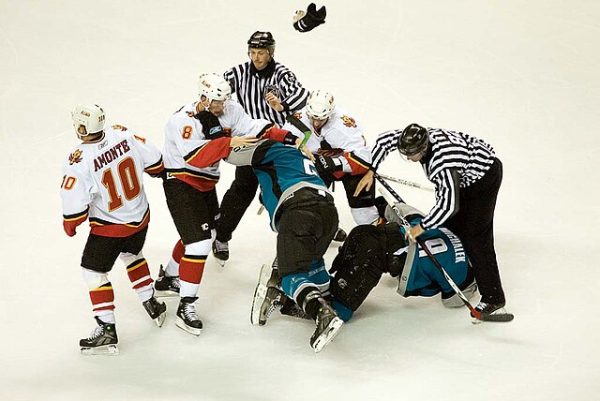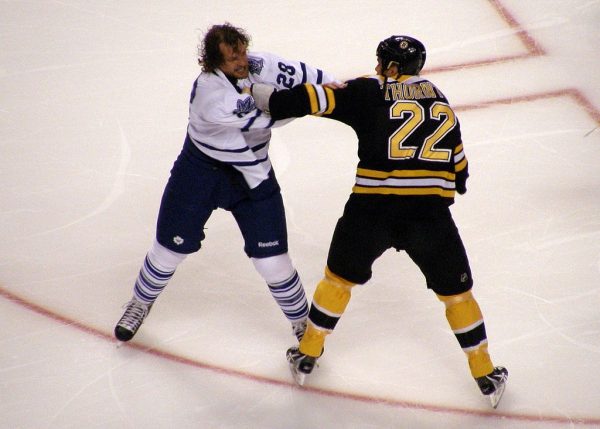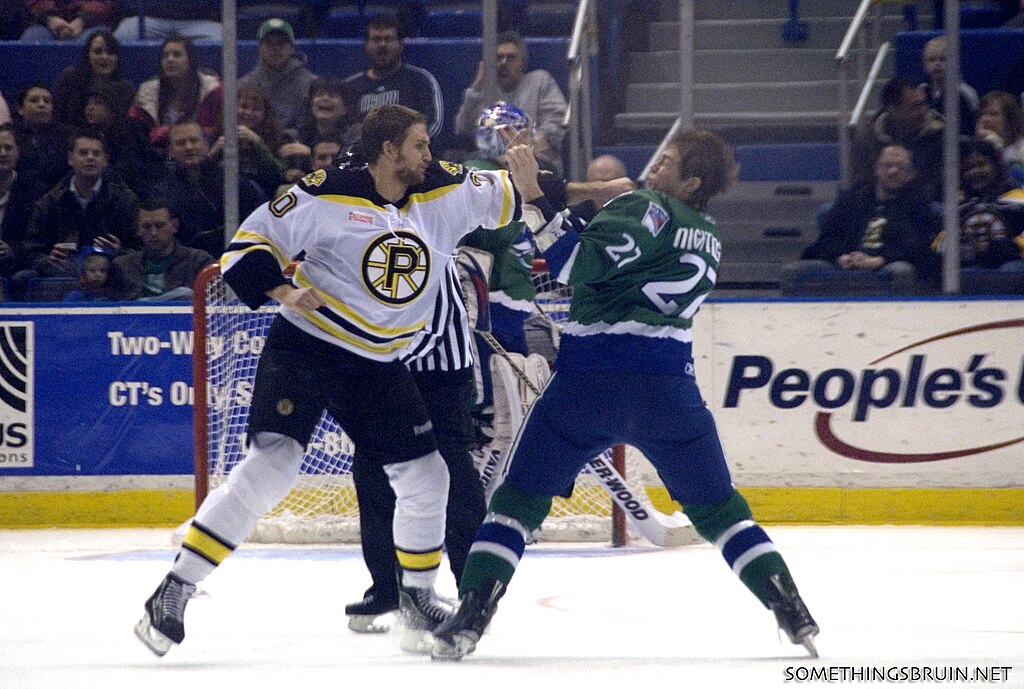If you’re watching a hockey game, there’s a fair chance that you will witness two players fistfighting in the middle of the game. For those unfamiliar with hockey, this may seem outlandish, but, for hockey fans and players, this is just another part of the game. The famous quote, “I went to a fight the other night, and a hockey game broke out,” by American comedian and actor Rodney Dangerfield, pokes fun at the idea that fighting is a major part of the game.
The National Hockey League (NHL) is the only professional sports league in North America — and one of the only sports worldwide — that allows players to fight each other. For NBA, NFL, or MLB players, engaging in a physical fight with a member of the opposing team would get that player in serious trouble. Suspension, up to $50,000 fines, and other serious punishments are on the table. But, in the NHL, five minutes in the penalty box is typically the only consequence.
This is not limited to the NHL, either. Fighting is ingrained in hockey culture and the sport of hockey in general. Players who have particularly good fighting skills even have an unofficial role: the “Enforcer.” These players are sometimes chosen by their teams specifically because of their ability to fight rather than their actual game abilities.
The Pros and Cons
So, why are people comfortable with hockey players fighting each other? Beyond the argument that it brings a level of entertainment to the table for fans, there are benefits for the players themselves. Fighting serves as a deterrent for unsavory play. Boarding, high-sticking, and dirty hits, are all examples of unfair plays that are dangerous to players, causing many serious injuries including concussions, ACL tears, and broken bones. Players know that if they injure players from the other team or play dirty, a fight is waiting for them. Fighting gives them a reason for to stay away from playing unfairly. For this reason, many people believe that fighting actually makes the game safer.

There are, of course, detriments. Opponents of fighting argue that fights cause injuries, set a bad precedent for youth, and glorify violence. The topic is a controversial one, and has made its way into major hockey conversations. Banning of fighting in professional hockey leagues has already begun, particularly for leagues consisting of minors.
Major junior hockey leagues consist of players typically between the ages of 16-20, serving as a bridge between youth hockey and professional hockey. The Canadian Hockey League (CHL) is an organization consisting of three extremely selective major junior hockey leagues. The CHL is known for producing top players, many of which are drafted by the NHL.
CHL players are treated as professionals. However, they are mostly comprised of players under the age of 18, so health and well-being is a particular concern. In response to these growing concerns, campaigns have begun advocating for rules protecting the safety of players in the CHL, particularly by getting rid of fighting. One of the three CHL leagues, the Quebec Major Junior Hockey League (QMJHL), has taken these campaigns seriously.
The QMJHL Fighting Ban
In March of 2023, the QMJHL tightened their rules and implied that a ban on fighting would be in their future. In August, they officially announced that fighting would no longer be allowed league wide. They ruled that any player who engaged in a fight would be immediately ejected from the game and face a one-day suspension. The ban was created with the purpose of protecting players from long term damage and injury caused by fighting. The QMJHL commissioner, Mario Cecchini, however, wants to attack the root of the problem: the culture of hockey that enables fighting.
“We obviously have to improve on these situations, and even eliminate them in some cases. How do you make a culture change? With a lot of determination, with a lot of conviction, and with a lot of precision and clarity in how you expect everyone to behave. For me, that’s going to be paramount,” Cecchini said.
The QMJHL is the first North American hockey league to make the decision to ban fighting, and it has proven to be very controversial. Those on the side of the ruling agree that the decision was necessary to protect players, many of whom are minors. The opposition, however, argues that banning fighting in junior hockey leagues leaves players entering the NHL unprepared for what professional level hockey is truly like.
For most avid hockey fans, fighting is an exhilarating part of watching the game. Since the decision of the QMJHL, many fear that this may signal a “beginning-of-the-end” of fighting in hockey as a whole. Fighting is ingrained in hockey culture, so letting go of the tradition feels outlandish to fans.
What do the Fans and Players think?
I spoke with Cecelia Chu ’24, a devoted fan and viewer of hockey. “I feel like people treat fighting as if it’s not an intrinsic part of hockey. Imagine if someone suggested we take fighting out of the WWE. You can’t just remove parts of the game,” said Chu. “Most serious hockey injuries don’t come from fighting, rather from hitting their heads on the ice, or getting hit into the boards, so I don’t know why people are so concerned about fighting specifically. I would say fighting even prevents some of that stuff.”
The real question, however, is: What do the players think?
I interviewed Harry Troy ’24, to help answer this question. Troy has been playing hockey since he was a kid. Like Chu, he believes that fighting in hockey is a positive.
Do you think fighting is an important part of the game?
“Look, it’s an absolutely necessary and essential part of the game. I’m not even about to call it a necessary evil. It’s a necessary necessity. It’s really a fundamental part of the game, just like shooting, passing, or skating. Fighting is there so you earn the respect of the other team, and, without the respect, they’re just going to walk all over you. They’re going to be cross-checking you, they’re going to be tripping you, they’re going to be hooking you [all examples of penalties], and you’re going to be having a bad day. You can’t let the bully walk all over you,; you’ve got to walk all over the bully and show them who’s the boss.”
Have you ever gotten into a fight?
“I mean, I stand at a cool 5’8 on skates, so I’m not what you would call an enforcer. However, I will get into a fight to support my teammates when it’s absolutely necessary. I never look for fights. I never instigate. I don’t go into any pre-planned fights or anything like that. However, I have gotten into maybe over this past year, maybe 2 ½ fights. And that was only with the help of other people. I usually don’t get into any individual fights,” Troy said.
Troy shares this opinion with many professional players. Ryan Reaves, a long-time NHL player, and known enforcer, spoke about how banning fighting could be a potential safety hazard, especially for star players. In an interview with Jackie Redmond and Kevin Weekes of NHL Network, Reaves shared his opinions on the proposal of a fighting ban in the NHL.
“You’re trying to get fighting out of hockey; I’m telling you, some of these superstars will be laid out [hit down]. You’re going to be missing guys like, you know, Crosby [one of the league’s best players], he might catch a knee if there’s no repercussions for it, and then all these GMs are going to be begging for a fight to get back.”
Reaves highlighted the point that fighting serves as a consequence for dirty play and that it could be dangerous to have these repercussions removed. Reaves also pinpointed how this could lead to top players being targeted by such plays.

Enrico Ciccone, a former NHL player and current politician, disagrees. Like Reaves, Ciccone was an enforcer during his time in the league. He, however, uses his past as a cautionary tale. In an interview with CBC, Ciccone stated that he experiences pain everyday, both physical and emotional, due to his many fights, and from having suffered a frightening six or seven concussions.
“As you know, things have changed through the years, and society has changed, and we have numbers, we have scientific reports also that [show] us the damage it can do on your brain,” Ciccone told CBC. “We just want to try to work ahead to make sure that these kids don’t go through what I went through.”
Ciccone also pointed out that fighting is already becoming less common in hockey than it used to be. “In my era, you know, it was a part of the game, it was a part of the game plan also — intimidation. But as we go through the years, you know … there’s less and less fighting,”
Is the proposal to ban fighting in the NHL being taken as a serious one? Currently, no. But with growing concern for the health of players, and the new banning of fighting in the QMJHL, the answer to that question may change in the next few years.
“I went to a fight the other night, and a hockey game broke out,” said the American comedian and actor Rodney Dangerfield.

